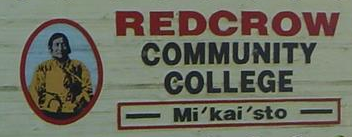Sipatsimo – Hierchloe odorata (Cree name: wihkes)
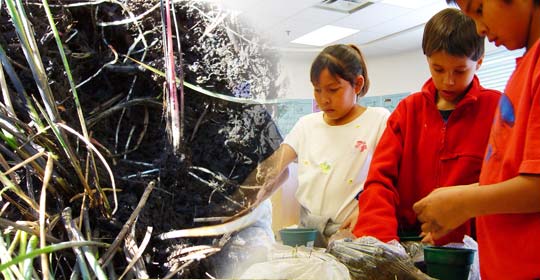
Kendra, Noah and Japheth planting Sweetgrass
Sipatsimo
Sipatsimo anistapi matoyihko. Saissksiimokoinattsi. Aipohko’tsi’pa ki iitayaamsstsinnii’pa. Nitao’toissiikootsiisinaan naato’kayi nitsitapoohpinaanistsi mi iita’nssimao’p, iikihkitsaahko ki mi matstsiki iikotsikahko. Mi otsitotsikahkohpi iiksinnoiyi miistsi sipatsimo ki mi otsitskitsaahkohpi iiksaahkii miistsi sipatsimo. Aisskssii’pa sipatsimo. Ihtaiksistsikimisstao’p, ihpaissiskinaawaatso’p, ki ihtawaamato’simao’p.
Sweetgrass
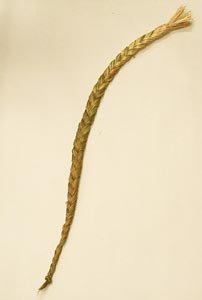
Hierchloe odorata
Galileo Educational Network
Sweetgrass is a smooth, flat-leaf bladed grass that grows 30-60 cm tall in moist areas. It likes low meadows or coulees. Elders Mary Rose and Margaret Gros Ventre Boy showed us that their roots have a purplish red color. It is harvested in late summer. Our teachers, Alvine Mountain Horse and Sylvia Gros Ventre Boy, showed us how to bind the stems at the lower end with other stems and how to braid it.
Sweetgrass is a sacred plant used for praying, ceremony and medicine.
Elder Shirley Mountain Horse told us that sweetgrass could be used as incense for praying and starting meetings. You can light the end of a braid or you can break off pieces and place them on hot coals and you smudge yourself with the smoke. The smoke helps to purify you and your thoughts. A special alter can be used to hold the sweetgrass. Sometimes it is mixed with tobacco and smoked in ceremonies. Elder Adam Delaney told us that you must treat sweet grass with respect and be mindful of how you hold it, where you put it and how you use it. It has special powers and is very holy.
Elders Shirley Mountain Horse and Alfredia Delaney told us that sweetgrass can used for many medicines. A tea can be taken for sore throats or for coughs. The tea can relieve sharp pains. A smudge can be inhaled for colds.
If you have windburn or chapped skin, a wash of sweetgrass tea helps the soreness. Sore eyes are also relieved with a wash of the tea.
The tea can be used as a hair tonic, to make your hair shiny and nice smelling. Our elders might have decorated their hair with sweetgrass. Ochre was sometimes mixed with sweetgrass to keep it smelling nice.
Our elders also used sweetgrass to doctor their horses and keep them nice smelling. A tea would be used for saddle sores and for keeping their coats shiny. Sweet grass was packed with saddles. Sometimes horses were given the sweetgrass to eat to increase their endurance.
Sweetgrass can be used in crafts, too. Some people use it to make frames. Elder Carolla Calf Robe makes them into tiny wreaths that can be worn as a broach. Our elders wove sweetgrass into braids as bands for their headdresses.
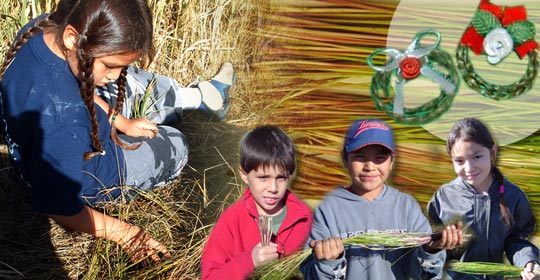
Marvin picking Sweetgrass. Noah, Japheth and Laney holding Sweetgrass bundles.
Marvin Calf Robe Sr. tells us stories about Sweetgrass:

Marvin Calf Robe Sr.
Chapter 1
Chapter 2
Chapter 3
Chapter 4
Foin d’odeur
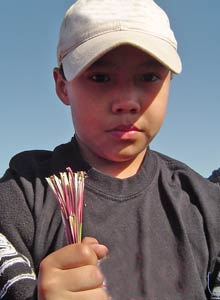
Hierchloe odorata
Alvine Mountain Horse
Le foin d’odeur est une herbe lisse à feuilles plates qui mesure de 30 à 60 centimètres de haut. Il pousse dans les régions humides, comme les prés en basse altitude et les coulées. Les aînées Mary Rose et Margaret Gros Ventre Boy nous ont montré que la couleur de la racine du foin d’odeur est pourpre-rouge. Ce foin est récolté vers la fin de l’été. Nos enseignants, Alvine Mountain Horse et Sylvia Gros Ventre Boy, nous ont appris comment attacher les tiges ensemble par le bas, puis les tresser. Le foin d’odeur est une plante sacrée dont nous nous servons pour prier, pour nos cérémonies et comme remède.
L’aînée Shirley Mountain Horse nous a dit que le foin d’odeur pouvait servir d’encens pour la prière et le début des rassemblements. Nous pouvons allumer le bout d’une tresse ou en casser des morceaux et les placer sur du charbon chaud pour en inhaler la fumée. La fumée aide à purifier notre corps et nos idées. Un autel spécial peut servir à tenir le foin d’odeur. Parfois, nous le mélangeons avec du tabac et le fumons pendant nos cérémonies. L’aîné Adam Delaney nous a dit que nous devons traiter le foin d’odeur avec respect et faire attention à la façon dont nous le tenons, où nous le mettons et comment nous nous en servons. Le foin d’odeur a des pouvoirs spéciaux et il est très saint.
Les aînées Shirley Mountain Horse et Alfredia Delaney nous ont aussi dit que le foin d’odeur peut prendre la forme de bien des remèdes. Le thé de foin d’odeur peut aider à guérir les maux de gorge et la toux. Ce thé peut aussi soulager les douleurs intenses. Nous pouvons aussi l’inhaler en cas de rhume.
Si nous sommes brûlés par le vent ou si nous avons la peau gercée, nous pouvons nous laver avec du thé de foin d’odeur pour enlever les douleurs. Le foin d’odeur soulage aussi les maux de yeux. Ce thé peut aussi servir de tonique pour les cheveux, ce qui les rend brillants et leur donne une bonne odeur. De plus, nos aînés décoraient parfois leurs cheveux avec le foin d’odeur. Parfois aussi, ils mélangeaient l’ocre au foin d’odeur pour que le tout sente bon.
Grâce au foin d’odeur, nos aînés pouvaient aussi soigner leurs chevaux et leur donner de bonnes odeurs. Le thé fait à partir de ce foin permettait de soigner les maux de garrot et de faire en sorte que le pelage des chevaux soit luisant. Nos aînés mettaient du foin d’odeur sur les selles. Parfois aussi, ils donnaient du foin d’odeur à manger aux chevaux pour accroître leur endurance.
Le foin d’odeur sert aussi à faire de l’artisanat. Certaines personnes font des cadres avec le foin d’odeur. L’aînée Carolla Calf Robe en fait de petites couronnes qui se portent sous la forme de broches. Nos aînés se faisaient des tresses avec le foin d’odeur et les portaient en guise de bandeaux dans leurs coiffes.
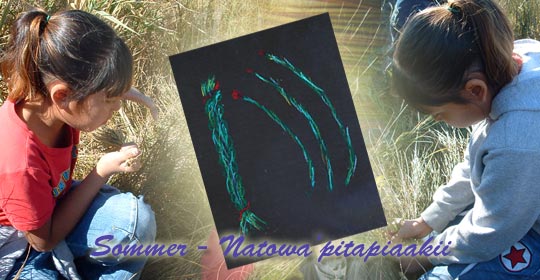
This is an original composition by Sommer (Natowa’pitapiaakii).
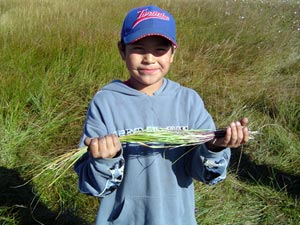
Hierchloe odorata
Galileo Educational Network
- Brown, Annora. (1954). Old Man’s Garden. Vancouver, British Columbia: Evergreen Press Limited.
- Calf Robe, C. (personal communication December 2,2004)referred to Sweetgrass.
- Delaney, A & A (personal communication November 12, 2004)referred to Sweetgrass.
- Glenbow Museum. (2005). Nitsitapiisinni Exhibit Calgary, Alberta: Blackfoot Gallery Committee.
- Gros Ventre Boy, M,S& M-R. (personal communication September 27,2004)referred to Sweetgrass.
- Hart, Jeff. (1992). Montana Native Plants and Early Peoples. Helena, Montana: Montana Historical Society Press.
- Hellson, John C. (1974). Ethnobotany of the Blackfoot Indians. Ottawa: National Museums of Canada.
- Johnston, Alex. (1987). Plants and the Blackfoot. Lethbridge, Alberta: Lethbridge Historical Society.
- Kerik, Joan. (1979). Living With The Land: Use of Plants by the Native People Of Alberta. Edmonton, Alberta: Provincial Museum of Alberta.
- Moerman, Daniel E. (1998). Native American Ethnobotany. Portland: Timber Press.
- Mountain Horse, A. (personal communication September 27,2004)referred to Sweetgrass.
- Mountain Horse, S. (personal communication October 4,2004)referred to Sweetgrass.
- Willard, Terry. (1992). Edible and Medicinal Plants of the Rocky Mountains and Neighboring Territories. Calgary, Alberta: Wildrose College of Natural Healing.



